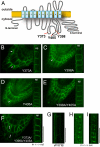Polar localization and degradation of Arabidopsis boron transporters through distinct trafficking pathways
- PMID: 20194745
- PMCID: PMC2841934
- DOI: 10.1073/pnas.0910744107
Polar localization and degradation of Arabidopsis boron transporters through distinct trafficking pathways
Abstract
Boron (B) is essential for plant growth but is toxic when present in excess. In the roots of Arabidopsis thaliana under B limitation, a boric acid channel, NIP5;1, and a boric acid/borate exporter, BOR1, are required for efficient B uptake and subsequent translocation into the xylem, respectively. However, under high-B conditions, BOR1 activity is repressed through endocytic degradation, presumably to avoid B toxicity. In this study, we investigated the localization of GFP-tagged NIP5;1 and BOR1 expressed under the control of their native promoters. Under B limitation, GFP-NIP5;1 and BOR1-GFP localized preferentially in outer (distal) and inner (proximal) plasma membrane domains, respectively, of various root cells. The polar localization of the boric acid channel and boric acid/borate exporter indicates the radial transport route of B toward the stele. Furthermore, mutational analysis revealed a requirement of tyrosine residues, in a probable cytoplasmic loop region of BOR1, for polar localization in various cells of the meristem and elongation zone. The same tyrosine residues were also required for vacuolar targeting upon high B supply. The present study of BOR1 and NIP5;1 demonstrates the importance of selective endocytic trafficking in polar localization and degradation of plant nutrient transporters for radial transport and homeostasis of plant mineral nutrients.
Conflict of interest statement
The authors declare no conflict of interest.
Figures





References
-
- Ma JF, et al. A silicon transporter in rice. Nature. 2006;440:688–691. - PubMed
-
- Ma JF, et al. An efflux transporter of silicon in rice. Nature. 2007;448:209–212. - PubMed
-
- Marschner H. Mineral Nutrition of Higher Plants. 2nd Ed. San Diego: Academic Press; 1995.
-
- O'Neill MA, Ishii T, Albersheim P, Darvill AG. Rhamnogalacturonan II: Structure and function of a borate cross-linked cell wall pectic polysaccharide. Annu Rev Plant Biol. 2004;55:109–139. - PubMed
-
- Nable RO, Banuelos GS, Paull JG. Boron toxicity. Plant Soil. 1997;193:181–198.
Publication types
MeSH terms
Substances
LinkOut - more resources
Full Text Sources
Molecular Biology Databases

